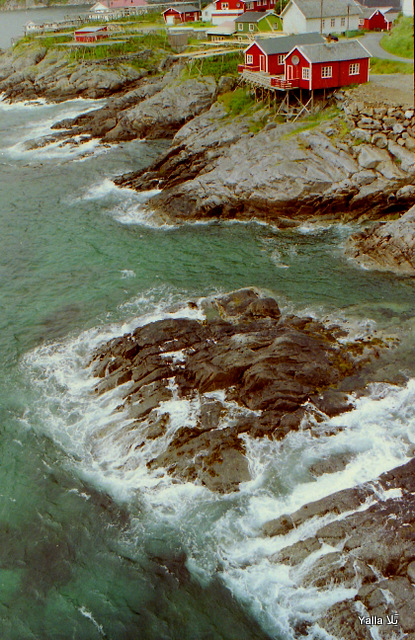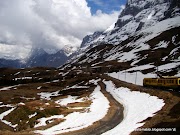Let us see a couple of numbers, just to get an idea of the dimensions of Norway. We flew in from my hometown Budapest to the Norwegian capital of Oslo, which is about 1480 km (920 miles) as the crow flies. Practically following the coastline from Oslo, we covered about 2300 km (1430 miles) until we reached the Lofoten islands. When we arrived, it really felt like being at the end of the world. Yet we still would have had to travel an additional 1050 km (653 miles) if we had wanted to get to the Nordkapp, the northernmost point of Norway (and Europe, for that matter).
Norvégia méreteinek érzékeltetéséhez lássunk néhány számot: Budapest és Oslo között nagyjából 1480 km-t repültünk légvonalban. A fővárosból tulajdonképpen végig a tengerpart mentén haladva 2300 km-t utaztunk, mire végül elértünk a Lofoten-szigetekre. Itt aztán már tényleg azt éreztük, hogy a világ végén járunk. Ha azonban el akartunk volna jutni a Nordkapp-ig (Norvégia, egyben Európa legészakibb pontja), még mindig várt volna ránk egy további 1050 km-es út.
Norway is one of the cleanest, safest and quietest countries I have ever been to. The Lofoten islands take all these to an even higher level. For a city-dweller like myself, the air is indescribably fresh. The sea is so clean that we could see for meters under the surface. Safety? The locks on doors probably serve as no more than decoration and this is the only place on Earth where an ATM gave me money without asking for my pin code! As for being quiet, the biggest noisemakers around here are the seagulls.
Norvégia az egyik legtisztább, legbiztonságosabb és legcsöndesebb ország, ahol valaha jártam. A Lofoten-szigeteken pedig mindez hatványozottan igaz. A levegő egy hozzám hasonló városlakó számára már szinte leírhatatlanul friss, a tenger pedig olyan tiszta, hogy méterekre leláttunk. A biztonság? Az ajtókon a zárak szerintem csak dísznek vannak, ráadásul ez az egyetlen hely a világon, ahol úgy adott ki pénzt egy ATM, hogy még a pin-kódot se kérte! Ami pedig a csendet illeti, a legnagyobb zajt egyértelműen a sirályok csinálják.
For me, the perfect village of this perfect archipelago is Å. This one-letter place is where the road ends, even the letter itself is the last one in the Norwegian alphabet. Rugged hills all around, a small bay with little red wooden houses on stilts plus lots and lots of fisk (fish). The economy means cod here so they are being dried everywhere and the two "tourist attractions" - Fiskevaersmuseum (Museum of Fishing) and Tørrfiskmuseum (Stockfish Museum) - are also focused on them.
E tökéletes szigetvilág számomra tökéletes települése Å. Itt már véget ér az út, még a falu nevét adó egyetlen betű is az utolsó a norvég ábécében. A meredek sziklás hegyoldalak közt húzódó apró öböl mentén fekvő falu mindössze pár cölöpökön álló piros faházból áll, illetve rengeteg száradó tőkehalból. A gazdaság itt tényleg egyenlő a tőkehallal, úgyhogy a még a két "turistalátványosság" - a Fiskevaersmuseum (Halászati Múzeum) és a Tørrfiskmuseum (Tőkehal Múzeum) - is róluk szól.
Beyond the sparsely populated villages, there is nothing but beautiful natural scenery. Vast open spaces, sharp peaks, very green fields and fjords of all sizes.
A településeket is elég szellősen lakják, rajtuk kívül pedig már tényleg csak a látványos természet van. Hatalmas érintetlen területek, meredek sziklafalak, nagyon zöld mezők és mindenféle méretű fjordok.
 |
| The beach at Bunes / A strand Bunes mellett |
When the Lofoten were inhabited by fishermen only, life might have been tough. Especially in the winter, when the sun does not rise for about a month. Today, all the comforts are available and despite being in the middle of nowhere, pretty much every place is easily accessible. While there may be only one bus per day serving some villages, that one bus will surely come sharp on time and the driver will understand English.
Yet we had the most fun at a place where comforts are deliberately forgone. In the tiny village of Stamsund, we stayed at a hostel that can still not be contacted online, only via phone. When we asked the friendly owner about places to eat, he pointed towards a small rowing boat and said "there's the boat and the fishing rods are over there, you can take them for free". At first we were a bit confused, thinking "...and then what?", but we eventually headed out to sea and ended up having the most cost-efficient and special meal of our trip: very fresh fish "served" with a bit of adventure.
 |
| Justad Rorbuer og Vandrerhjem, Stamsund |
Amikor a Lofoten-szigeteken még csak a halászok laktak, valószínűleg keményebb volt az élet. Főleg télen, amikor egy egész hónapon át nem kel fel a nap. Mára azonban minden adott a kényelmes léthez. Hiába vannak a szigetek a semmi közepén, minden hely könnyedén elérhető. Bár néhány faluba csak egy busz megy naponta, az az egy busz biztosan percre pontosan érkezik, a sofőr pedig biztosan ért angolul.
Mi azonban ott éreztük legjobban magunkat, ahol bizonyos kényelemről kénytelenek voltunk lemondani. Stamsund apró falujában egy olyan szállást választottunk, amelynek - egyébként igen barátságos - tulajdonosa még ma sem hajlandó online kommunikálni, csak telefonon. Amikor megkérdeztük, tud-e javasolni valamilyen vacsorázási lehetőséget, rámutatott egy csónakra és azt válaszolta, hogy "ott a csónak, ott pedig a horgászbotok, elvihetitek ingyen". Bár első gondolatunk az volt, hogy "...és aztán mi lesz?", végül kieveztünk a tengerre és az egész utunk legkülönlegesebb és leginkább költséghatékony vacsorájával zártuk a napot: nagyon friss hallal, némi kalanddal "fűszerezve".







